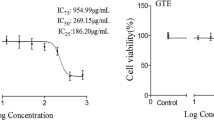Abstract
Leaves of Rubus suavissimus S. Lee (Rosaceae) are used to prepare tiencha or sweet tea, which is helpful for body weight control by restricting calorie intake in obese patients. Obesity is a risk factor for metabolic syndrome, and a possible approach to treatment is to promote early adipogenesis in adipose tissue, thereby leading to replacement of enlarged adipocytes that secrete inflammatory factors with small adipocytes.We therefore investigated the effect of extract of tiencha leaves on early adipogenesis by using 3T3-L1 preadipocytes as a model. Tiencha extract significantly and concentration-dependently increased adipogenesis measured in terms of lipid accumulation by means of Oil Red O assay and increased the expression of adiponectin and leptin. In the early phase of adipogenesis, tiencha extract increased the mRNA expression of adipogenic transcription factors CCAAT/enhancer binding protein α (C/EBPα) and proliferator-activated receptor γ (PPARγ). In contrast, mRNA expression of other adipogenic transcription factors, C/EBPδ and C/EBPβ, was unaffected. The mRNA expression levels of adipocyte-specific genes encoding adipocyte protein 2 (aP2), lipoprotein lipase (LPL), and glucose transporter 4 (Glut4), which are regulated by C/EBPα and PPARγ, were also increased. A PPARγ inhibitor, GW9662, partially inhibited the enhancing effect of tiencha extract on lipogenesis. These results suggest that tiencha extract enhances early adipogenesis by increasing the expression of adipogenic transcription factors C/EBPα and PPARγ.




Similar content being viewed by others
References
Kopelman PG (2000) Obesity as a medical problem. Nature 404:635–643
Nishimura S, Manabe I, Nagasaki M, Eto K, Yamashita H, Ohsugi M, Otsu M, Hara K, Ueki K, Sugiura S, Yoshimura K, Kadowaki T, Nagai R (2009) CD8+ effector T cells contribute to macrophage recruitment and adipose tissue inflammation in obesity. Nat Med 15:914–920
McLaughlin TM, Liu T, Yee G, Abbasi F, Lamendola C, Reaven G, Tsao P, Cushman S, Sherman A (2009) Pioglitazone increases the proportion of small cells in human abdominal subcutaneous adipose tissue. Obesity (Silver Spring) 18:926–931
Hassan M, El Yazidi C, Landrier JF, Lairon D, Margotat A, Amiot MJ (2007) Phloretin enhances adipocyte differentiation and adiponectin expression in 3T3-L1 cells. Biochem Biophys Res Commun 361:208–213
Abe D, Saito T, Kubo Y, Nakamura Y, Sekiya K (2010) A fraction of unripe kiwi fruit extract regulates adipocyte differentiation and function in 3T3-L1 cells. Biofactors 36:52–59
Cho KW, Lee OH, Banz WJ, Moustaid-Moussa N, Shay NF, Kim YC (2010) Daidzein and the daidzein metabolite, equol, enhance adipocyte differentiation and PPARgamma transcriptional activity. J Nutr Biochem 21:841–847
Green H, Kehinde O (1975) An established preadipose cell line and its differentiation in culture. II. Factors affecting the adipose conversion. Cell 5:19–27
Rosen ED, MacDougald OA (2006) Adipocyte differentiation from the inside out. Nat Rev Mol Cell Biol 7:885–896
Farmer SR (2006) Transcriptional control of adipocyte formation. Cell Metab 4:263–273
Nakamura K (1998) Anti-allergic activity of tiencha and oolong tea polyphenols. Food Style 21:45–49
Ono Y (2002) The health beneficial effects of Tien-cha (Rubus suavissimus tea) and its applications. Food Style 21:77–80
Student AK, Hsu RY, Lane MD (1980) Induction of fatty acid synthetase synthesis in differentiating 3T3-L1 preadipocytes. J Biol Chem 255:4745–4750
Ramirez-Zacarias JL, Castro-Munozledo F, Kuri-Harcuch W (1992) Quantitation of adipose conversion and triglycerides by staining intracytoplasmic lipids with Oil red O. Histochemistry 97:493–497
Tang QQ, Otto TC, Lane MD (2003) CCAAT/enhancer-binding protein beta is required for mitotic clonal expansion during adipogenesis. Proc Natl Acad Sci USA 100:850–855
Darlington GJ, Ross SE, MacDougald OA (1998) The role of C/EBP genes in adipocyte differentiation. J Biol Chem 273:30057–30060
Yeh WC, Cao Z, Classon M, McKnight SL (1995) Cascade regulation of terminal adipocyte differentiation by three members of the C/EBP family of leucine zipper proteins. Genes Dev 9:168–181
Tang QQ, Jiang MS, Lane MD (1999) Repressive effect of Sp1 on the C/EBPalpha gene promoter: role in adipocyte differentiation. Mol Cell Biol 19:4855–4865
Gregoire FM, Smas CM, Sul HS (1998) Understanding adipocyte differentiation. Physiol Rev 78:783–809
Ishikawa Y, Suwa Y, Okada T, Kohno S (1995) Anti-allergic effects of Rubus suavissimus extract. Inflamm Regen 15:167–173
Tsuboi H, Sugimoto Y, Kainoh T, Ichikawa A (2004) Prostanoid EP4 receptor is involved in suppression of 3T3-L1 adipocyte differentiation. Biochem Biophys Res Commun 322:1066–1072
Sugimoto N, Sato K, Liu HM, Kikuchi H, Yamazaki T, Maitani T (2002) Analysis of rubusoside and related compounds in tenryocha extract sweetener. Shokuhin Eiseigaku Zasshi 43:250–253
Nakahara K (1998) Anti-allergic activity of tiencha and oolong tea polyphenols. Food Style 2:45–49
Li H, Tanaka T, Zhang YJ, Yang CR, Kouno I (2007) Rubusuaviins A–F, monomeric and oligomeric ellagitannins from Chinese sweet tea and their alpha-amylase inhibitory activity. Chem Pharm Bull (Tokyo) 55:1325–1331
Adams LS, Seeram NP, Aggarwal BB, Takada Y, Sand D, Heber D (2006) Pomegranate juice, total pomegranate ellagitannins, and punicalagin suppress inflammatory cell signaling in colon cancer cells. J Agric Food Chem 54:980–985
Author information
Authors and Affiliations
Corresponding author
Rights and permissions
About this article
Cite this article
Ezure, T., Amano, S. Rubus suavissimus S. Lee extract increases early adipogenesis in 3T3-L1 preadipocytes. J Nat Med 65, 247–253 (2011). https://doi.org/10.1007/s11418-010-0480-z
Received:
Accepted:
Published:
Issue Date:
DOI: https://doi.org/10.1007/s11418-010-0480-z




